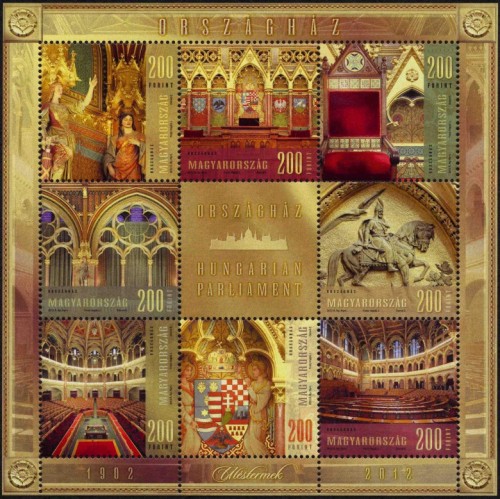
1. MAGYAR - MŰVÉSZETEK 2012 - PARLAMENT - Bélyeg rendelési kód: S2012/04
2. ENGLISH - ARTS 2012 - PARLAMENT - Order code of the stamp: S2012/04
3. GERMAN - KÜNSTE 2012 - PARLAMENT - Die Bestellnummer Der Marke: S2012/04
1. MAGYAR - MŰVÉSZETEK 2012 - PARLAMENT
Az Országház a világ egyik legszebb középülete. Különleges építészeti megoldásait új filatéliai sorozat dolgozza fel és mutatja be. Két évvel az Országház hivatalos átadása előtt, 110 évvel ezelőtt kezdődött el a munka a főrendiház és a képviselőház üléstermeiben, ezért a sorozat első darabján az Országház üléstermei szerepelnek. A kisív közepén az Országház-sziluettel díszített szelvényt a főrendiház és a képviselőház üléstermeinek különböző részleteit ábrázoló nyolc bélyeg öleli körbe. A kisív speciális változatban, dombornyomással és lakkdíszítéssel, exkluzív tartóban is megjelent.
Az ország házának felépítéséről az Országgyűlés (1880. évi LVIII. tc.) törvényt alkotott és tervpályázatot hirdetett. A pályázatra tizenkilenc terv érkezett, közülük Steindl Imre historizáló eklektika jegyében született elképzelése valósult meg. Az 1885-től 1904-ig tartó építkezéshez – a Svédországból érkezett, főlépcsőt tartó márványmonolitok kivételével – kizárólag hazai építőanyagokat használtak fel. Az első kapavágásra 1885. október 12-én került sor a Tömő-tér talaján. Az építkezésen átlagosan ezer ember dolgozott, 176.000 köbméternyi földet mozgattak meg, 40 millió téglát, félmillió díszkövet és 40 kg aranyat használtak fel.
Az épület központi eleme a kupola, amelynek két oldalán emelkedik a képviselőház (ma az Országgyűlés) és a volt főrendiház (ma Kongresszusi terem) ülésterme. A Duna felőli oldal a főhomlokzat, de a hivatalos főbejárat a Kossuth térről nyílik. Kívül és belül összesen 242 szobor van a falakon, de jeles freskók és festmények is díszítik az Országházat. (Forrás: hu.wikipedia.org)
Példányszám: 50.000 db (alap) 10.000 db (speciális) kisív.
Forrás: Posta
2. ENGLISH - ARTS 2012 - PARLAMENT
The 110-year old chambers of the Parliament on the latest stamp specialty of Magyar Posta
The Parliament is one of the most beautiful public buildings in the world. Its special architectural solutions are processed and presented by a new philatelic series. In the chambers of the Upper House and the Representatives, the work started 110 years ago, two years before the official opening of the Parliament, therefore the first piece of the series depicts the chambers of the Parliament. In the middle of the miniature sheet, the segment decorated by the silhouette of the Parliament is surrounded by eight stamps depicting various details of the chambers of the Upper House and the Representatives. The miniature sheet has been issued in a special version, with embossing and lacquer decoration, too, in an exclusive holder.
The Parliament framed a law on the construction of the Houses of Parliament (Statute LVIII of 1880), and conducted a design competition. Nineteen designs were submitted in the competition, from which Imre Steindl's idea worked out in the spirit of historic eclecticism was realised. For the construction that lasted from 1885 to 1904 – except for the marble monoliths that hold the main stairs and were imported from Sweden – only domestic building materials were used. The first sod was cut on 12 October 1885 on the soil of Tömő-tér. On an average, one thousand people worked on the construction, 176,000 m3 of soil was moved, and 40 million bricks, half a million decorative stones and 40 kg of gold were used.
The central element of the building is the dome, on the two sides of which there are the chambers of Representatives (today’s Parliament) and the Upper House (today: congress hall). The main facade is on the Danube side, but the official entrance is from Kossuth square. Inside and outside, there are altogether 242 statues on the walls, and the building is decorated by outstanding frescoes and paintings, too. (Source: hu.wikipedia.org)
3. GERMAN - KÜNSTE 2012 - PARLAMENT
Die hundertjährigen Sitzungssäle des Parlamentsgebäudes
auf der neuesten Briefmarkenbesonderheit der Magyar Posta
Das Parlament ist eines der schönsten öffentlichen Gebäude weltweit. Die neue philatelistische Serie verarbeitet und präsentiert seine besonderen architektonischen Lösungen. Vor 110 Jahren, zwei Jahre vor der offiziellen Übergabe des Parlamentsgebäudes, begannen die Arbeiten in den Sitzungssälen des Oberhauses und des Abgeordnetenhauses, deshalb sind auf den ersten zwei Marken der Serie die Sitzungssäle des Parlamentsgebäudes zu sehen. Der Abschnitt mit der Silhouette des Parlamentsgebäudes in der Mitte des Kleinbogens ist von acht Briefmarken umgeben, die Details der Sitzungssäle des Oberhauses und des Abgeordnetenhauses abbilden. Der Kleinbogen erschien auch in einer Spezialausgabe mit Reliefdruck und Lackverzierung, in exklusiver Klemmtasche.
Die Nationalversammlung verabschiedete ein Gesetz über den Bau des Parlamentsgebäudes (Gesetz Nr. LVIII von 1880) und schrieb einen Wettbewerb aus. Neunzehn Bewerber legten ihre Pläne vor, davon wurde Imre Steindls Idee im Geist des historischen Eklektizismus umgesetzt. Für den von 1885 bis 1904 dauernden Bau wurden mit Ausnahme der die Haupttreppe stützenden Monolithen aus Marmor, die aus Schweden geliefert wurden, nur inländische Baumaterialien verwendet. Die Bauarbeiten begannen am 12. Oktober 1885 auf dem Tömő-Platz. Auf der Baustelle arbeiteten im Durchschnitt tausend Menschen, 176.000 Kubikmeter Erde wurden bewegt und 40 Millionen Ziegel, eine halbe Million Schmucksteine sowie 40 kg Gold wurden verwendet.
Der Mittelpunkt des Gebäudes ist die Kuppel, an deren beiden Seiten sich der Sitzungssaal des Abgeordnetenhauses (jetzt das Parlament) und der Sitzungssaal des ehemaligen Oberhauses (heute Kongresshalle) befinden. Die Hauptfassade geht nach der Donau, der offizielle Hautpeingang ist auf dem Kossuth-Platz. An den Außen- und Innenwänden sind insgesamt 242 Skulpturen zu finden, aber auch hervorragende Wandmalereien und Gemälde schmücken das Parlamentsgebäude. (Quelle. hu.wikipedia.org)










